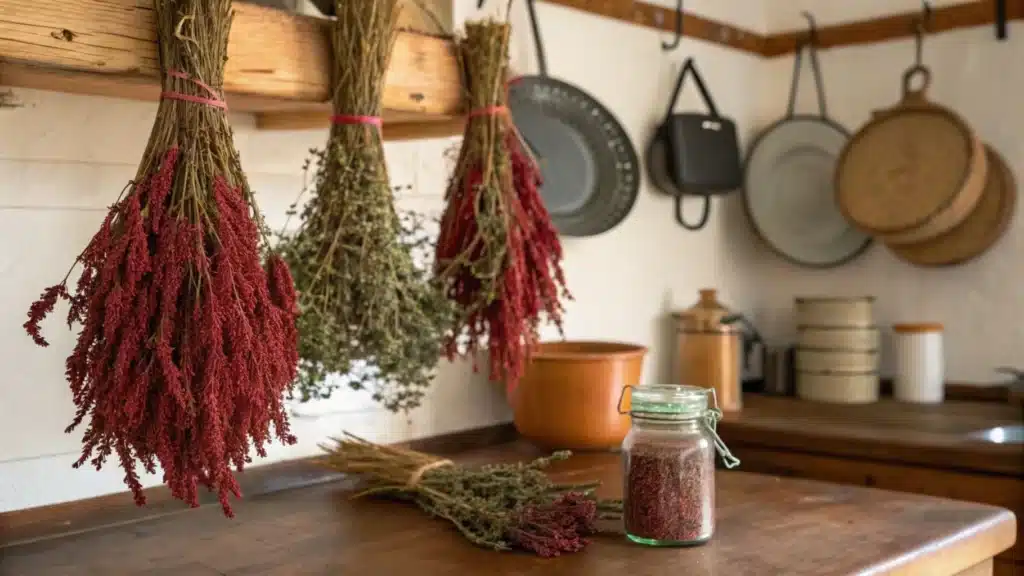Red Creeping Thyme is more than just a beautiful addition to your garden. This aromatic and hardy herb, with its vibrant red flowers and evergreen foliage, is a true gem for gardeners and edible plant enthusiasts alike. Used for centuries in both cooking and traditional medicine, it offers a wealth of benefits—from enhancing your dishes with its bold flavor to providing natural health benefits. In this article, discover how to grow and enjoy red creeping thyme in your garden while exploring its culinary, medicinal, and ecological advantages.
Table of Contents
Understanding Red Creeping Thyme
Red Creeping Thyme (often referred to as crimson thyme) is a unique variety of creeping thyme that offers both culinary and medicinal benefits, making it an excellent choice for gardeners interested in edible plants. This plant thrives in a variety of soil types, preferring well-drained soil with compost to enhance soil quality. Known for its green foliage and low-growing nature, it forms a lush creeping thyme lawn that adds texture to gardens. Unlike common thyme, which has a more upright growth habit, red creeping thyme’s shallow root system allows it to spread quickly, making it an ideal ground cover.
When considering soil requirements, red creeping thyme flourishes in alkaline soil, benefiting from soil conditioners like compost. It is also highly tolerant of dry summer conditions and moderate water, making it suitable for regions with dry summers. Its growth rate is relatively slow, but with proper care, you can enjoy its fresh growth and vibrant flower production in late summer. Whether you’re growing it for its aromatic flavor or its medicinal properties, red creeping thyme is a hardy and versatile plant that adapts well to a variety of environments.
Botanical Characteristics
Red creeping thyme, scientifically known as Thymus praecox ‘Coccineus’, is part of the mint family. It’s a hardy perennial that thrives in a variety of conditions, showing off its vibrant red blooms during the summer months. The plant is low-growing, forming a dense mat that can reach up to 4 inches in height and spread 12 to 18 inches wide. Its foliage is evergreen in mild climates, turning a lovely bronze in autumn. This plant is not just beautiful but also functional, attracting beneficial insects and deterring deer.
Growth Habits
Red creeping thyme grows vigorously, creating a lush carpet that can withstand light foot traffic. It’s a creeping plant, meaning it spreads outwards rather than upwards, making it ideal for ground cover. The stems become woody over time, which helps the plant anchor itself firmly to the soil. However, this woody stem characteristic can also mean it requires regular pruning to maintain its lushness and prevent it from becoming too leggy.
Ideal Growing Conditions
For optimal growth, red creeping thyme needs well-draining soil to avoid root rot, a common issue if the soil retains too much moisture. It prefers full sun but can tolerate partial shade. Plant it in areas where it can bask in at least six hours of sunlight daily to ensure abundant flowering. Amend heavy soils with sand or organic matter to improve drainage, and keep an eye on moisture levels, especially during wet seasons. This plant is drought-tolerant once established, making it a low-maintenance choice for eco-friendly landscapes.
Culinary Uses of Red Creeping Thyme
Flavor Profile and Pairings

Red creeping thyme is a powerhouse in the kitchen, offering a robust and earthy flavor that can elevate any dish. Its flavor is subtly peppery with a hint of mint, making it a versatile herb in various cuisines. This thyme variety pairs beautifully with roasted meats, particularly lamb and chicken, and complements vegetables like potatoes and carrots. For a refreshing twist, try combining it with citrus fruits or berries.
Cooking Techniques
Incorporating red creeping thyme into your cooking is straightforward. Here are a few methods to get the most out of its flavor:
- Infusions: Add sprigs to oils or vinegars for a fragrant infusion.
- Roasting: Toss whole sprigs with vegetables or meats before roasting to impart a rich, aromatic flavor.
- Herb Butter: Mix finely chopped thyme leaves into softened butter for a flavorful spread.
Preservation Methods

Preserving the essence of red creeping thyme ensures you have its flavor available year-round. Here are some techniques:
- Drying: Hang bundles upside down in a dry, dark place. Once dried, strip the leaves and store them in an airtight container.
- Freezing: Chop the leaves and freeze them in ice cube trays with a little water or olive oil. This method preserves the flavor well.
- Herb Salt: Combine dried thyme with salt to create a seasoned salt blend perfect for seasoning dishes.
Red creeping thyme, like other varieties of thyme, is an essential herb that adds depth and complexity to your culinary creations, ensuring every meal is a flavorful experience.
Medicinal Benefits
Traditional Healing Practices
Red creeping thyme has been a staple in herbal medicine for centuries. Ancient healers prized it for its ability to soothe coughs and aid digestion. It was often brewed into teas or used in poultices to relieve respiratory ailments and skin irritations. Its versatility in traditional remedies highlights its enduring value in natural health practices.
Modern Scientific Insights
Today, scientists are uncovering the secrets behind red creeping thyme’s healing powers. Research shows it contains potent antimicrobial properties, making it a natural ally in fighting infections. Additionally, its anti-inflammatory effects are gaining attention for their potential to ease conditions like arthritis. This herb, rich in essential oils, is also being studied for its possible immune-boosting benefits.
Incorporating into Wellness Routines

Integrating red creeping thyme into your daily wellness routine is simple and rewarding. Consider these methods:
- Brew a soothing thyme tea to help with digestion.
- Use thyme-infused oils for topical relief of minor skin irritations.
- Add fresh or dried thyme to your meals for a healthful flavor boost.
Embracing red creeping thyme in your lifestyle not only enriches your palate but also supports your journey towards natural wellness. Its multifaceted benefits make it a valuable addition to any health-conscious regimen.
In addition to red creeping thyme’s traditional healing practices, many other herbs offer similar medicinal benefits. For example, gardenias are known for their relaxing and medicinal properties as well.
Red Creeping Thyme in Landscaping
Designing with Thyme
Red creeping thyme is a fantastic choice for adding a splash of color and texture to your garden. Its low-growing nature makes it perfect for ground cover, creating a vibrant carpet of green and red. This plant thrives in well draining soil, making it ideal for areas like rock gardens. To make the most of its beauty, consider these design tips:
- Use it as a border plant to define garden edges.
- Mix with taller plants to create a layered look.
- Incorporate into pathways for a fragrant, colorful walk.
Companion Planting Benefits
The creeping thyme plant is not just a pretty face; it offers numerous benefits when used as a companion plant. It deters pests like deer and cabbage worms while attracting beneficial insects. Here’s why it’s a great companion:
- Natural antibacterial properties help protect neighboring plants.
- Enhances the garden’s ecosystem by attracting pollinators.
- Complements vegetable gardens with its subtle aroma.
Creating Eco-Friendly Lawns
Traditional grass lawns are water-intensive and often require harmful chemicals. Red creeping thyme presents an eco-friendly alternative. It requires less watering frequency and thrives in sunny spots. Consider these advantages:
- Low maintenance and drought-tolerant.
- Releases a pleasant scent when walked on.
- Supports biodiversity by providing habitat for insects.
Transform your landscape with red creeping thyme, a plant that not only beautifies but also supports a healthy environment. Embrace the change towards sustainable gardening with this versatile and resilient plant.
Red creeping thyme can be a fantastic ground cover in eco-friendly gardens. For more low-maintenance plants that work well in sustainable landscapes, discover our article on small palm trees
Cultivating Red Creeping Thyme
Planting and Care Tips
Planting red creeping thyme, also known as Thymus praecox, can be a rewarding experience for both novice and seasoned gardeners. Begin by selecting a sunny spot with well-draining soil. This herb thrives in poor soil conditions, making it an excellent choice for areas where other plants struggle. Whether you’re planting seeds or young plants, ensure the soil is loose; adding sand can improve drainage. When planting, space the plants about 12 to 18 inches apart to allow for growth. Water them well after planting, especially if you’re dealing with a hot summer or a cold winter.
Pruning and Maintenance
Regular pruning is key to maintaining a healthy and vibrant thyme patch. Trim your thyme twice a year, once in early spring and again after the flowers have bloomed. This encourages new growth and a second round of blooms. Avoid pruning too late in the season to prevent damage from frost. If your thyme spreads too much, consider dividing the root ball and replanting it elsewhere or sharing with fellow gardeners.
Pest and Disease Management
Red creeping thyme is naturally resistant to many pests and diseases due to its antibacterial properties. However, poor drainage can lead to root rot. To prevent this, ensure your soil is well-drained. If you notice signs of root rot, amend the soil with organic matter like compost or leaf mold. For propagation, stem cutting is a reliable method, especially for Thymus serpyllum and Thymus vulgari. Keep an eye out for any pest activity and address it promptly to keep your thyme healthy.
Environmental Impact
Supporting Biodiversity
Red creeping thyme is more than just a pretty plant. It plays a significant role in boosting biodiversity. This low-growing herb attracts beneficial insects like bees and butterflies, contributing to a thriving garden ecosystem. By providing a habitat for these pollinators, red creeping thyme helps maintain a balanced environment. This plant also repels pests, reducing the need for chemical pesticides that can harm local wildlife.
Biodiversity plays a crucial role in maintaining healthy ecosystems and supporting plant life. Learn more about its importance in this National Park Service article.
Water Conservation Benefits
One of the standout features of red creeping thyme is its ability to thrive with minimal water. Unlike traditional lawns that require frequent watering, this herb is drought-tolerant, making it an excellent choice for water conservation. During dry spells, it maintains its vibrant look without heavy irrigation. This not only saves water but also reduces the gardener’s workload.
Soil Health Improvement
Red creeping thyme enhances soil quality through its natural growth processes. The plant’s roots help prevent soil erosion, and its dense foliage provides cover that shields the soil from harsh weather. Moreover, as thyme decomposes, it enriches the soil with organic matter, boosting microbial activity. This process improves soil structure and fertility, making it a sustainable choice for gardeners looking to improve their land’s health.
Red creeping thyme is a powerhouse in the garden, offering ecological benefits that go beyond its aesthetic appeal. Its presence can transform ordinary spaces into vibrant, self-sustaining ecosystems.
Red creeping thyme is an excellent choice for drought-tolerant ground covers. For more plants that thrive with minimal water, consider planting a pomegranate tree
Aromatherapy and Red Creeping Thyme
Essential Oil Extraction
Red creeping thyme, with its aromatic foliage, is a fantastic source for essential oils. The process of extracting these oils is straightforward but requires care to maintain the plant’s natural essence. Typically, the leaves are distilled, capturing the rich, earthy aroma that thyme is known for. This method not only preserves the scent but also the therapeutic properties of the oils.
Stress Relief Applications
Incorporating red creeping thyme into your aromatherapy routine can provide significant stress relief. The oils derived from this herb are known to promote relaxation and reduce anxiety. Here’s how you can use it:
- Diffusion: Add a few drops of thyme oil to a diffuser to fill your space with its calming scent.
- Bath Soak: Mix thyme oil with Epsom salts for a soothing bath that eases tension.
- Massage: Blend thyme oil with a carrier oil for a relaxing massage that targets stress points.
Enhancing Home Ambiance
Transform your living space into a haven of tranquility with red creeping thyme. Its scent can enhance any room, creating a welcoming and serene atmosphere. Consider these ideas:
- Potpourri: Combine dried thyme leaves with other herbs and flowers for a natural air freshener.
- Candles: Infuse candles with thyme oil to enjoy its aroma as they burn.
- Room Spray: Create a simple spray using thyme oil and water for a quick refresh of your home.
Red creeping thyme thrives in dry conditions, making it a resilient choice for both gardens and aromatherapy. Its robust nature ensures that even in less-than-ideal environments, you can still enjoy its benefits.
Conclusion
Red creeping thyme is more than just a pretty plant for your garden. It’s a versatile herb that offers culinary delights, medicinal benefits, and ecological advantages. Whether you’re looking to spice up your meals, support local wildlife, or simply enjoy a low-maintenance ground cover, this plant has something for everyone. Its ability to repel pests, attract pollinators, and thrive in dry conditions makes it a smart choice for any gardener. So, if you’re thinking about adding a new plant to your garden, consider red creeping thyme. It’s easy to grow, beneficial for the environment, and a joy to have around.
Frequently Asked Questions
What is red creeping thyme, and where can it grow?
Red creeping thyme is a type of perennial herb that belongs to the mint family. It grows well in sunny spots with well-drained soil and is hardy in zones 4-9.
How do I use red creeping thyme in cooking?
You can use red creeping thyme to add flavor to dishes like roasted veggies, meats, soups, and stews. It has a slightly lemony taste that pairs well with lots of foods.
What are the health benefits of red creeping thyme?
Red creeping thyme has been used in traditional medicine for its antiseptic and anti-inflammatory properties. It may help with coughs and digestion.
How do I plant and care for red creeping thyme?
Plant red creeping thyme in a sunny spot with good drainage. Water it occasionally, especially in dry weather, and trim it back to keep it tidy.
Can red creeping thyme replace a grass lawn?
Yes, red creeping thyme can be used as a lawn alternative. It creates a low-maintenance, eco-friendly lawn that blooms and smells nice when walked on.
Does red creeping thyme attract pollinators?
Yes, red creeping thyme attracts bees and butterflies, which helps support local ecosystems and biodiversity.


2 thoughts on “Red Creeping Thyme: Culinary and Medicinal Garden Essential”